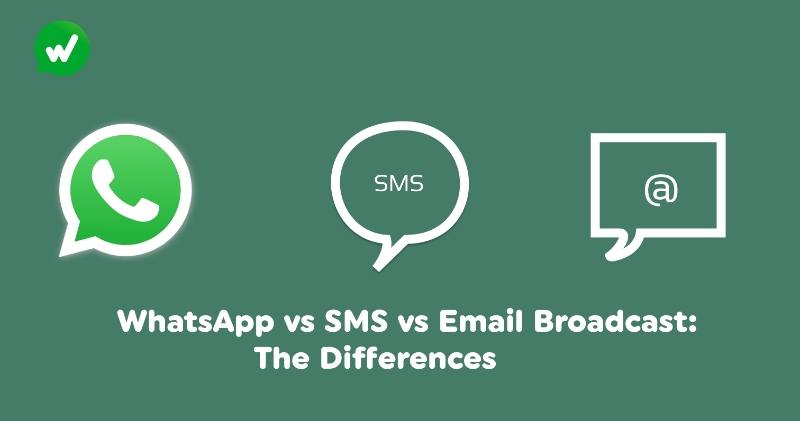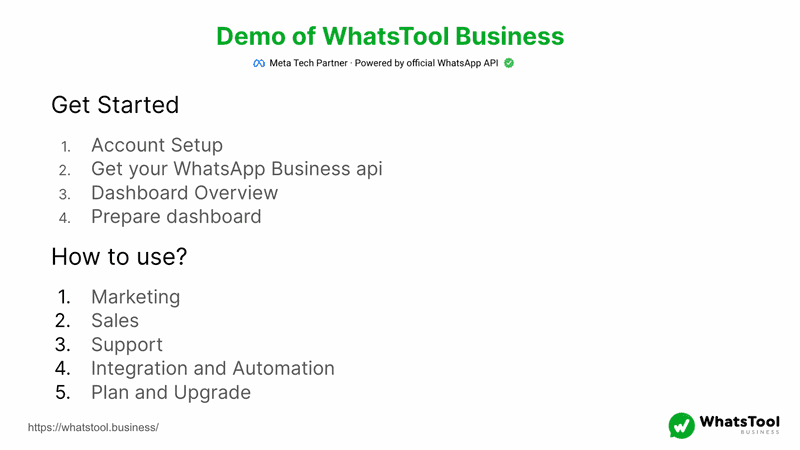
Clear and timely communication is key to building a great business. Whether you’re looking to send out marketing messages or notifications, these need to be done right.
From traditional SMS and email to popular platforms like WhatsApp, there are plenty of channels that are equipped to help businesses communicate effectively.
In this post, we’ll explore the three most popular broadcast channels: WhatsApp, SMS, and email. That way, you have the information you need to make an informed decision.
What Is SMS Broadcast?
SMS broadcast, also known as mass texting and bulk SMS, is a communication method that allows you to send the same message to multiple recipients via Short Message Service.
With SMS broadcast, recipients won’t be able to tell whether it’s been mass-sent to others. However, by that same token, it’s also not possible to set up group chats.
Because of the nature of SMS broadcast, which is mostly used for short text messages, it’s most commonly used for alerts and transactional messages such as shipment notifications, and payment confirmations.
Here are some pros and cons of SMS broadcasts you need to know about.
Pros of SMS Broadcast
- SMS broadcast messages can be sent and received on any mobile device, including non-smartphones. This allows you to target customers who don’t own smartphones.
- Recipients cannot tell whether the message was mass sent.
- SMS broadcast messages do not rely on data or WiFi and can be sent when there’s no internet connection.
Cons of SMS Broadcast
- It’s text-based only and does not support media file
- There’s a 160-text limit for each SMS.
- Senders cannot tell whether a message has been read.
SMS Broadcast Tools
It’s important to do some research into the top SMS broadcast tools to see which is a good fit for your brand.
We’ve done some legwork for you and here are some of the top SMS broadcast software available.
Call Loop
Call Loop’s SMS broadcast features include the possibility to personalize your messages (by incorporating the first and/or last names of your recipients and customizing each text to their names). It also provides analyses and reports of your SMS marketing activities.
A free 14-day trial is available so you can test it first before committing to them.
CallHub
CallHub allows users to schedule their messages and set up automatic replies. This is especially useful for brands with an international audience across different time zones.
They also offer a pay-as-you-go plan so for fair usage and fees.
SimpleTexting
SimpleTexting is another great SMS broadcast tool as it has an extensive list of features. This includes the possibility to import your contact list from CSV files or a Google sheet.
Plus, they offer integrations with the top business tools like Zapier, HubSpot, Salesforce, and more.
What Is Email Broadcast?
An email broadcast is when a single email is sent to a group of people at once. It’s also known as email blast and email marketing.
Unlike SMS broadcast, email broadcast can be set up such that its recipients can see who else has been sent the same message. Email broadcast messages can also be configured such that their contents are personalized to the recipient.
Because it supports multimedia features such as images and has no word limit, email broadcasts are commonly used for marketing and promotional purposes.
Pros of Email Broadcast
- It’s easy to send targeted and personalized messages with email broadcasts.
- There’s a lot of flexibility for design as you can attach images, gifs, and even videos.
- It has a high ROI (Return on Investment) of $36.
Cons of Email Broadcast
- It’s not uncommon for email broadcasts to end up in spam.
- Because email is more widespread than SMS these days, the chances of your recipients simply skimming over or even skipping your email entirely are high.
- Design is key when sending out email marketing broadcasts. This can be time-consuming and tedious.
Email Broadcast Tools
The best email broadcast tools offer a host of features and integrations and aren’t too costly.
Some of these tools mentioned below offer either free trials or free plans so you can test and compare them.
HubSpot
HubSpot is one of the leading software for marketing, sales, and customer service. Their email broadcast tool comes with design templates that you can easily adapt.
It also allows you to carry out A/B testing and provides full analytics so you know what can be improved.
Mailchimp
One of the best things about the email broadcast tool Mailchimp is its integrations. Shopify and Stripe are great ones to have for eCommerce businesses, and integrations with social media platforms like LinkedIn and Facebook also allow you to combine all your marketing efforts.
Mailchimp offers a free plan with basic features. If you’re a new business with a tight marketing budget, this is something worth looking into.
Sendinblue
Sendinblue has been listed as one of the best email broadcast software for sending out transactional emails. But it can help with so much more than that.
It has a feature that advises you on the best time to send out an email for maximum impact and also offers integrations with CRMs, eCommerce pages, and more.
If you’ve opted to do SMS broadcast and email broadcast, Sendinblue is a great solution as it offers both of these tools.
What Is WhatsApp Broadcast?
Having covered SMS and email broadcast above, it should be clear what WhatsApp broadcast is.
As you’ll probably have guessed, WhatsApp broadcast pertains to sending a message to several recipients at the same time via WhatsApp, the world’s most popular chat app.
Like SMS broadcasts, WhatsApp broadcast messages appear to their recipients as individual messages. We won’t go into the full features of WhatsApp broadcast as we’ve covered them in a previous post.
WhatsApp broadcast is often confused with WhatsApp group. The two are different in that messages in WhatsApp groups are visible to all participants, whereas WhatsApp broadcast conversations are private between the sender and the receiver only.
Pros of WhatsApp Broadcast
- Recipients cannot tell whether the message they received was mass sent.
- WhatsApp broadcast messages can make use of all WhatsApp features, including media sharing, location sharing, and more.
- You can save your WhatsApp broadcast recipient list for future messages so you don’t have to select all of them every time you want to send out a broadcast.
Cons of WhatsApp Broadcast
- WhatsApp has strict policies in place. Businesses must acquire explicit consent from customers before sending them messages or face penalties.
- WhatsApp broadcast messages will only be received by people who have saved you as a contact (more on this later).
- Unlike SMS, which works on all mobile phones and comes pre-installed, WhatsApp is an additional app that needs to be downloaded and works on smartphones only.
WhatsApp Broadcast Tools
While there are many different tools and software available for SMS and email broadcast, there are essentially only three WhatsApp broadcast tools.
This is because WhatsApp is an app and a platform on its own, whereas SMS and email are methods of communication that can be carried out across different channels.
What this means is that WhatsApp broadcast is available on three different WhatsApp products: WhatsApp Messenger, the free WhatsApp Business app, and the WhatsApp Business API.
WhatsApp Messenger and WhatsApp Business App
The WhatsApp Messenger and WhatsApp Business apps are free to download. Both come with broadcast features that are very easy to use.
Though there’s no limit on the number of lists you can create, each list is allowed a maximum of 256 contacts.
WhatsApp Business API
Because the WhatsApp Business API has more enterprise features, there are lots more businesses that can do with WhatsApp broadcasts.
For starters, you can schedule your broadcasts to go out at predetermined times and recipients also don’t need to have their number saved to receive your broadcasts. Plus, there’s also no 256-contact limit.
WhatsApp vs SMS vs Email Broadcast
So, should you opt for SMS, email, or WhatsApp broadcast?
There’s no one-size-fits-all answer and it will ultimately depend on your business needs and what your target audience prefers.
As mentioned earlier, SMS broadcasts work better for notifications, due to their text-only nature and short word limit. Emails, on the other hand, are more commonly used for newsletters.
With WhatsApp broadcast, you have more possibilities to adapt and customize your messages thanks to its features. As the world’s most popular chat app with over two billion users worldwide, the chances of your target buyer being active on WhatsApp are also pretty high.
That being said, neither of these is mutually exclusive, so you’re free to give them all a try and see what works best for you.
Read Other Blogs - View


